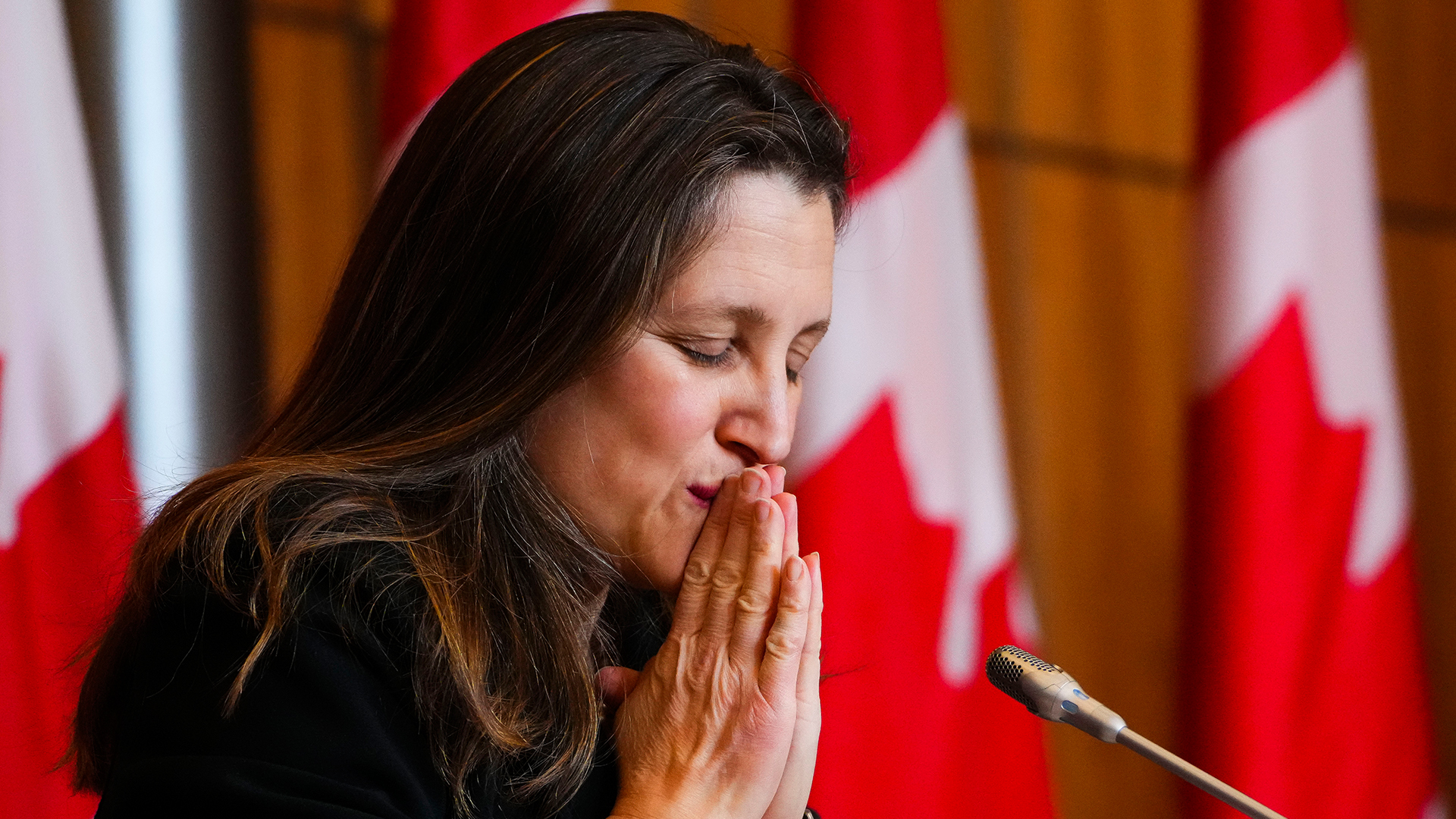
Unprecedented spending by the federal and provincial governments in response to public health, economic and social pressures created by the global COVID-19 pandemic has led to significant budget deficits for some governments and/or the exacerbation of chronic budget shortfalls in others. Between 2019 and 2022, Canada saw its federal net debt-to-GDP ratio skyrocket from 29.8 per cent to a projected 47.5 per cent, while the Canadian general government (which combines all levels of government) net debt-to-GDP ratio rose from 55.1 per cent to 70.7 per cent between 2019 and 2021.
The federal government has signalled its intent to roll back COVID-related programs and deficits, and begin work toward a balanced budget by the 2026-27 fiscal year, targeting a deficit of 0.4 per cent of GDP and a net debt-to-GDP ratio of 44 per cent. There are few details on how this is to be accomplished, other than winding down pandemic-related stimulus spending in 2022-23, keeping expenditure growth to less than three per cent annually and achieving revenue growth of more than four per cent annually.
However, as the Parliamentary Budget Officer (PBO) pointed out in his January 2022 analysis, this forecast does not take into account additional spending promises made in the 2021 Liberal election platform. Increasingly, economists such as Kevin Page, the first PBO, opposition critics and right-leaning organizations, such as the Canadian Taxpayers Federation, Fraser Institute and C.D. Howe Institute, are suggesting that without a clear fiscal roadmap, the government’s debt and deficit forecasts are vulnerable. They argue that these estimates are highly contingent on rapid, post-pandemic economic growth and that there is no fiscal room if another shock occurs.
To change the trajectory of federal spending, start big and follow the money
Three ways to make government spending more accountable and efficient
We argue that there is considerable uncertainty about whether Canada’s deficit and debt-reduction goals can be achieved without a more deliberative intervention to reduce spending. To our thinking, the question is not whether a major expenditure review will be required, but rather when it will begin and how it will be designed. If previous Canadian practice is followed, cuts will be accomplished through the imposition of top-down reduction mandates, rather than a more targeted sectoral approach. Although this top-down method is the most expedient, the resulting budget savings can come at the expense of internal and external legitimacy, create unintended inequities in the federation, or encounter constraints due to constitutional or regulatory requirements (e.g., limits with respect to transfer payments). As noted by Catalano and Erbacci (2018), there is little evidence that top-down, across-the-board spending cuts within jurisdictions achieve lasting efficiencies in the delivery of government programs and services.
We suggest that because expenditure reduction has not yet become an urgent political imperative, Canada has a window of opportunity to design a new, overarching policy compass for spending and policy reviews that embraces a multi-jurisdictional approach. A salient feature of Canada’s pandemic response is that it has been developed, negotiated and implemented through unprecedented collaboration with all levels of government. The federal government assumed most of the costs, and much of its spending consisted of transfers to provinces and territories for service delivery. It is reasonable to assume that expenditure reductions associated with winding down pandemic spending and returning to balanced budgets will also have to be negotiated and planned across all jurisdictions. The pandemic created expectations on collaborative federalism that will be difficult to reverse.
A national approach is needed
The federal government has a major fiscal challenge, which is not fully captured by the usual macro indicators such as deficit numbers, public debt ratios and inflation pressures. Consider these points:
1. Every federal department and agency had to pivot to address the pandemic crisis. Some rolled out extraordinarily large programs, often to deliver services in new ways, in partnership with different levels of government, and with new technologies and processes. Which programs and intergovernmental programs arising from the pandemic do we retain, realign or jettison?
2. Every jurisdiction in Canada is facing similar deficit and debt risks. Federal budget decisions will have repercussions for its provincial and territorial partners, and for the arms-length agencies that are tasked with service delivery. Knowledge of program effectiveness, and where efficiencies might be achieved, similarly rests with these partners. Is there an opportunity to identify, negotiate and implement cuts or program reorientations multilaterally to maximize the chances of success?
3. Officials expected to think about potential spending reviews, such as those involved in financial and risk management, audit, evaluation and performance functions have been overwhelmed by the size, scope and speed of pandemic-related expenditures. In the past, governments were inclined to rely on central agencies or large consulting houses to undertake reviews, with limited opportunity for wider stakeholder input. Is it possible to create a more consensus-based process that includes a broader range of public service and outside expertise to inform the reviews?
4. Sector-level strategies have not always been sought, limiting the insights that could be gained from a multiplicity of actors. How can the authorities and capabilities of all levels of government and non-governmental actors be harnessed to arrive at legitimate and feasible solutions that encourage participation, without compromising the need to drive towards a common vision for the future?
If the complexity of the current challenge is not recognized, and the federal government instead relies on a cuts-oriented exercise focused exclusively on spending within its own sphere – without considering the opportunities created by pandemic collaboration with provinces and territories – it risks making short-term, less-informed decisions.
Considering alternative approaches
In thinking about how to design a new review process, many will point to Canada’s comprehensive 1994-95 Program Review, long considered a global best practice. However, that review was the culmination of efforts spanning three governments and 13 years. The Macdonald Commission (1982-85) and the Nielsen Task Force on Program Review (1984-86) initiated conversations about how the federation should address national challenges and manage its economic affairs. In 1994, the Liberal government of Jean Chrétien instituted a new federal budgeting process that placed significant weight on far-reaching, systematized internal and external consultations which informed the 1990s program review exercise. Each of these contributions paved the way for making difficult budgetary choices and trade-offs.
Despite its past success, it is not clear that this approach will serve Canada in dealing with its challenges in these difficult and uncertain times. The comparative evidence suggests that Canada has primarily relied on episodic, closed, unilateral and relatively comprehensive reviews since the 1990s. In contrast to some international peers, we do not have much recent experience in systematically, fulsomely and publicly rethinking priorities in policy sectors in a forward-looking way, as part of these spending reviews. Indeed, spending reviews in federations do not necessarily have to be unilateral, focus only on medium-term fiscal policy stabilization or be comprehensive in scope.
Canada can draw on the experience of other countries that have engaged in spending and strategic reviews, some episodically (like Canada), and others more regularly, with varying degrees of openness and engagement (like Australia). The OECD, in reports from 2011, 2013 and 2017, documented a range of practice with respect to how regularly reviews are carried out; the fiscal framework within which they proceed; how widely the review processes engage outside experts and the public; how many sectors are examined each year; and the extent to which the process is dominated by central agencies or delegated to the affected ministries or intergovernmental teams. The OECD experience suggests that such spending reviews can achieve more lasting success, with less disruption to necessary programs and services, when processes are democratized and not left to bureaucratic insiders.
This is not to suggest that the federal government must undertake a national comprehensive program review under a major governmental restructuring exercise. Time is of the essence. Comprehensive strategies entail political risk, significant mobilization of administrative resources and less detailed consideration of the programs of any one sector. That said, informed by its own and international experience, Canada could still opt for a more open discussion about the ultimate goals and conditions that could underpin its spending or policy reviews, however selective. The timing is propitious for the federal government to consider leading a new, regular, forward-looking and nationally oriented sectoral process.
From invention to practice: design considerations
What might a new national spending review process look like — one that is sectoral and aligned with current approaches to co-operative federalism? It would have to anticipate the inevitable politics and possibilities of a regionally diverse country, and also take advantage of the goodwill already present on several important intergovernmental policy fronts.
Several possible models could emerge, but a general roadmap could be developed through a co-ordinated federal/provincial/territorial approach to create a national fiscal framework to inform understandings of budgetary constraints and trade-offs in the short and medium term. This could be facilitated by convening a series of conferences that would:
- Include a range of voices, including government officials, sector experts and interest groups;
- Develop and assess different future scenarios for Canada’s policy sectors;
- Demarcate phases for a comprehensive national program review process, including the identification and timing of selective and staggered reviews in priority policy domains over several years; and
- Identify requirements for a co-ordinated, consistent approach to data collection and analysis, across all programs and departments.
These broad design considerations leave considerable scope for what a new generation of spending or policy reviews in Canada might look like. We need information, dialogue and decisions that will prepare Canada well for the futures it will likely encounter, respect the autonomy of its governments to make their own decisions and ensure that our scarce resources across levels of government and sectors are as aligned as possible. Coming out of a pandemic affords a prime opportunity for such discussion of new processes, rather than expediently focusing on spending reduction.
















